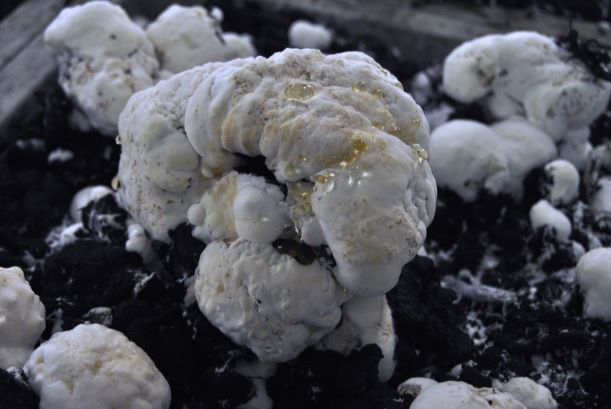Please click here to access the main AHDB website and other sectors.
- Home
- Knowledge library
- Fungal diseases in mushrooms: Wet Bubble disease
Fungal diseases in mushrooms: Wet Bubble disease
Wet Bubble disease shares some of the symptoms of Dry Bubble. Find out what to look for, how infection can spread and what to do to minimise damage if you spot an outbreak.
Symptoms of Wet Bubble disease
Wet Bubble disease (Mycogone) symptoms can be similar to those caused by Dry Bubble disease.
The main symptom is the development of large undifferentiated and irregular masses of tissue.
Other features to look out for include severely malformed mushrooms, with:
- Heavily swollen stipes
- Deformed caps
- Wart-like growths
- Cap spotting
- Amber-coloured droplets on bubbles, resulting in rotten tissue
In severe cases, white mycelium can grow out onto the surrounding casing, turning brown as the spores mature.
How Wet Bubble disease spreads
Wet Bubble (Mycogone) produces two spore types: a small fragile short-lived spore and a larger, tougher long-lived chlamydospore.
The tougher walled spores can be present in soil, surviving in compost and casing debris on mushroom farms. Outbreaks are usually associated with contamination of the casing or water supply with soil or other dust and debris.
Left untreated, the wet bubbles produce masses of small short-lived spores, then larger chlamydospores. Both spread through crops and onto surrounding surfaces when they are watered. They mix with casing and compost debris on floors, and can then be spread around the farm on footwear and blown around on the wind. Unlike with Dry Bubble, the spores are not sticky, so are not spread by flies.
Treating the disease
- Clearly mark all areas to be treated.
- Remove localised pieces of Wet Bubble disease carefully, using a disposable glove or plastic bag.
- Once in the bag or glove, carefully invert the bag or glove over it, close securely and dispose of safely.
- Dampen some strong, double thickness paper tissue and cover the affected area with a border of at least 5 cm.
- If there are growing mushrooms beneath the paper, try to break the connection with the casing, to stop growth.
- Check the areas regularly to make sure there has been no regrowth nearby.
If you can see wet bubbles, spots and misshapen mushrooms spreading over a wide area, it means that a piece of Wet Bubble was watered over at the end of the last flush and the infection has spread.
If this happens, follow the same steps as with Dry Bubble:
- Cover the area as before and consider terminating the crop at the end of the flush
- Don’t water it again if taking to another flush
- Review your hygiene procedures and make sure they’re being followed
Useful links
Other fungal diseases: Dry Bubble Disease
Other fungal diseases: Cobweb Disease
Learn how to manage fungal diseases in mushrooms
Images are courtesy and copyright of INAGRO and Teagasc


